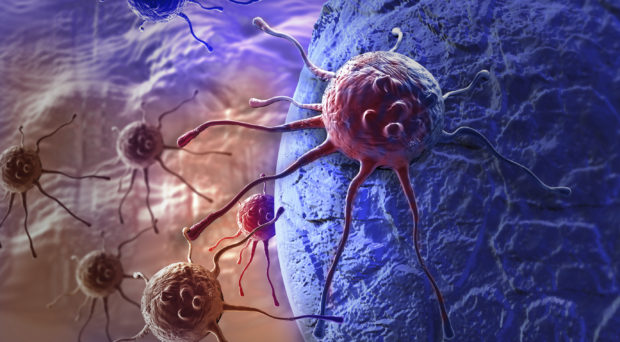
Translational cancer research was the mainstay of oncology conferences that BMC Medicine attended this year, such as EACR and ESMO. After impressive success in clinical trials, understanding underlying mechanisms of immunotherapy has become a priority, as these findings will aid clinical decisions. Tumor heterogeneity observed at many levels also fuelled studies on mutational signatures of human cancers. Here, we describe recent BMC Medicine articles fitting into these current trends that were published in our cross-journal Translational Oncology article collection Guest Edited by Prof Tommaso Dragani.
Natural killer cell-based adoptive immunotherapy is effective for bladder cancer
Natural killer (NK) cells are essential in the innate immune response to virus-infected and cancer cells. However, tumor cells may develop mechanisms to avoid recognition by NK cells and in this way protect themselves against their “natural killing” ability.
A potential therapeutic option is restoring NK cell function by their adoptive transfer.
A potential therapeutic option is restoring NK cell function by their adoptive transfer. Cells obtained from the patient (autologous approach) or from a healthy donor (allogeneic) are grown in vitro to larger numbers and activated to be returned to the patient.
A recent pre-clinical study explored this approach against chemoresistant bladder cancer cells. NK cells from healthy individuals proved to be more effective than ones from bladder cancer patients, suggesting that allogeneic approach may be an attractive option in high-grade non-muscle invasive bladder cancer.
High tumor-associated macrophages density predicts adverse outcomes in classical Hodgkin lymphoma
Tumor environment comprises of multiple cell types, which may promote or hinder tumor growth and progression. Macrophages infiltrating tumor tissues, so-called tumor-associated macrophages (TAMs), may speed up tumor progression and limit therapy response in a number of cancer types.
As recent studies suggest, targeting TAMs is a promising new approach in antitumor therapy.
A recently published meta-analysis confirmed that increased density of TAMs predicted adverse outcomes also in adult classical Hodgkin lymphoma. High TAM density was associated with poorer overall survival, shorter progression-free survival, and more advanced clinical stage.
These findings allow stratifying patients into high- and low-progression risk groups, which may facilitate therapy decision-making. On the other hand, as recent studies suggest, targeting TAMs is a promising new approach in antitumor therapy.
Novel approach to predict mutational load and correlate it with immunotherapy outcomes
Immunotherapy turned out to be a game-changer in cancer treatment, however not without its limitations. The most important issue is a significant number of patients being resistant to immunotherapeutics.
Tumor landscape, mutational load and neoantigen load may determine immunotherapy response and clinical outcomes.
Recent findings suggest that tumor landscape, mutational load and neoantigen load may determine immunotherapy response and clinical outcomes. Roszik et al. described a novel algorithmic approach that allowed prediction of tumor mutation load and correlating it with immunotherapy clinical outcomes.
The group assessed patients with lung cancer treated with pembrolizumab and melanoma treated with ipilimumab and adoptive T-cell therapy. Their approach is based on small next generation sequencing gene panels that are already in use to aid clinical decisions for targeted therapies in cancer.
Spatial transcriptome analysis of glioblastoma in subventricular zone reveals gene signature of prognostic value
De novo glioblastoma is a very aggressive cancer with poor prognosis. It is also very heterogeneous and its clinical presentation and treatment response vary from patient to patient. Heterogeneity relates also to the tumor location with tumors located close to the subventricular zone (SVZ) being associated with particularly poor outcomes.
De novo glioblastoma is a very aggressive cancer with poor prognosis.
As the molecular background of glioblastoma in the SVZ was largely unknown, Jungk et al. looked at SVZ-dependent gene expression in the mRNA microarray study. The group identified a signature of four genes that distinguishes this particular tumor location and is useful in assessing patient prognosis.
What’s important for future therapeutic options, two of these genes are involved in Notch signaling, suggesting that patients with glioblastoma in the SVZ may benefit most from Notch inhibitors that are currently evaluated in clinical trials.
Over the last years in cancer research, researchers and clinicians realized that “Cancer is not a single disease with a single type of treatment.” Not only the disease course differs by tumor location, but also there are intricate differences between individuals and tumor clones within one lesion. Understanding these variances at the molecular level and the underlying mechanisms is key to find treatments for specific cancer types. That’s what translational oncology tries to tackle and that’s why so much effort is currently put into these studies.
Are you working on novel translational cancer research? Consider submitting your manuscript to our new cross-journal article collection on Translational Oncology. The journals included in this collection are:
- BMC Medicine,
- BMC Cancer,
- Cancers of the Head and Neck,
- Clinical Sarcoma Research and
- Journal of Experimental and Clinical Cancer Research.
The article collection is now accepting submissions of original research articles that provide important developments in cancer research. Preclinical studies should provide a significant advance in knowledge, and have clear potential for strong clinical impact.
 BMC Medicine: passionate about quality, transparency and clinical impact
BMC Medicine: passionate about quality, transparency and clinical impact
2015 median turnover times: initial decision three days; decision after peer review 40 days
Comments